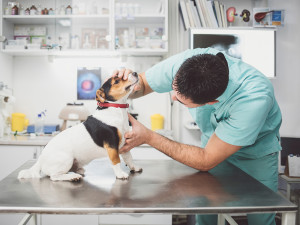Is an Underactive Thyroid to Blame For Low Energy?
If hypothyroidism is to blame, it’s best not to let sleeping dogs lie

share article
We all think our dogs are the best, but let’s be honest, sometimes they can be super-lazyopens in a new tab. While it’s normal for dogs to sleep for large portions of the day there is a point at which it becomes concerning. If you find yourself thinking what was initially cute is quickly becoming excessive, especially if weight gain is involved, this may not be run-of-the-mill sleepy pup syndrome. Instead, it could be a serious condition known as hypothyroidism.
What is hypothyroidism in dogs?
Fluctuations in hormones caused by inflammation or shrinkage of the thyroid gland cause hypothyroidism in dogs. Primary hypothyroidism is the most common hormonal disorder in dogs. The average onset of hypothyroidism in dogs is at seven years old. It is often found in large breed dogs – such as Doberman Pinschers, Golden Retrievers, Irish Setters, Great Danes and Boxers – and some smaller types – including Cocker Spaniels, Dachshunds, Poodles and Miniature Schnauzers.
Signs of hypothyroidism in dogs
The classic signs of hyperthyroidism in dogs include weight gain, lethargy, cold intolerance, skin and coat changes (yeasty-smelling fur; dark, lacy patches in the groin; excess shedding), vague and subtle symptoms that have snuck in slowly. Basically, your dog’s metabolism is working at a snail‘s pace.
Hypothyroid dogs tend to have elevated fasting cholesterol and triglycerides, elevated liver values and mild anaemia. Less often, they exhibit neurological weakness, poor appetite, corneal deposits, slow heart rate, heart arrhythmia or infertility.
Causes of hypothyroidism in dogs
While overproduction of thyroid hormones is often closely associated with cancer, it is rarely the reason for hypothyroidism in dogs. Rather, more than 95 percent of hypothyroid canine cases are caused by unknown gland atrophy or immune destruction of the thyroid. When damaged, the gland cannot respond as well to the TSH (thyroid-stimulating hormone) secreted from the pituitary gland to make T4 (levothyroxine) and T3 (triiodothyronine), the currency used by the body for the metabolism of energy.
How do you diagnose and treat hypothyroidism?
Once diagnosed, hypothyroid dogs tend to respond well to a long-term, twice-daily dosage protocol of oral levothyroxine. Typically, within four to six weeks, they have more energy, start to lose weight and coats begin to shine again. After T4 levels normalise, some dogs can be transitioned to a once-a-day medication schedule.
Sometimes, however, a dog’s thyroid disorder is atypical – their blood work doesn’t match the signs or vice versa. A dog may be suffering from other illnesses that lower T4, and certain medications can decrease thyroid levels as well. Adding to the confusion, for some dogs – such as sighthounds, Basenjis, or athletic dogs – thyroid levels are normally low. So how do we know if a dog is truly hypothyroid?
Thyroid test for dogs
Vets in the UK will use thyroid panels, such as IDEXX, to evaluate TgAA (antithyroglobulin antibodies), autoantibodies to the thyroid. A TgAA that is greater than 35 percent of the positive control value is positive for the presence of lymphocytic thyroiditis, but might not indicate full-blown hypothyroidism.
A caveat – TgAA can be elevated even when the dog is not yet truly hypothyroid. Because the gland must lose at least 60 percent of its function before clinical signs can be observed – which can take years, or may never happen – retesting a dog every six to 12 months is recommended.
To further define the results, vets recommend testing fT4ED (free T4 by equilibrium dialysis) when T4AA [a subset of TgAA] have been documented, non-thyroidal illness is known to be present, or the dog has received interfering substances such as steroids or phenobarbital.
Some common medications can interfere with tests
Some medications lower T4 levels such as phenobarbital, trimethoprim-sulfonamide, zonisamide, clomipramine and any glucocorticoid (drugs that stop inflammation, such as oral or topicals for ears, eyes and skin). So, if your dog is being given one of these medications, one way to clarify blood results is to work with your vet to safely wean him off the medication. After halting the medication for the prescribed period, blood work can be rechecked. If it’s not possible to stop a medication, a 6–8 week levothyroxine trial is sometimes employed.
In the end, after all the grey areas and questions, hypothyroidism comes down to this: treat the dog, not the blood work. Your dog’s vet can help you sort through the diagnostics and set up an appropriate monitoring schedule. Until then, don’t sleep on the warning signs.
Thyroid panel test
Here’s a tip sheet for decoding the results of your dog’s hypothyroid test.
TT4: Total T4 measures both protein-bound and free T4 levels. Various tissues convert free T4 to T3 to be used by the body. T4 is commonly decreased in hypothyroid dogs, but concurrent illness and many drugs can also falsely lower it. However, if it is normal, it is very unlikely that the dog is hypothyroid, and no further testing is necessary.
fT4: Free T4 measures T4 not bound by protein (the form that’s converted to T3). It is often decreased in hypothyroid dogs. Concurrent illness and drugs can lower it.
fT4ED: Free T4 by equilibrium dialysis (rather than by direct radioimmunoassay, or RIA), separates the free T4 from protein-bound T4. The dialysate, which is the part of a mixture that passes through the membrane in dialysis (containing the free T4), is then assessed by RIA. The fT4ED is less affected by seizure medications, steroids and euthyroid illness, but it cannot be used to clarify ambiguities when a dog is on sulfa drugs. It is not affected by the presence of TgAA.
Total T3, reverse T3 and free T3: Free T3 is the active form of thyroid, converted from free T4 to be used by the body. Because they fluctuate independently of hypothyroid status, T3 results are less reliable indicators of hypothyroidism.
TSH: Thyroid-stimulating hormone is secreted by the pituitary to stimulate T4 when T4 is low from true thyroid disease, certain medications, systemic illness and levothyroxine withdrawal; 85 percent of hypothyroid dogs with low TT4 will have elevated TSH; those who do not make it harder to confirm the diagnosis.
TgAA: Antithyroglobulin antibodies, which, when present at greater than 35 percent, suggest immune-mediated thyroiditis. These antibodies can affect TT4 and free T4 results, complicating diagnosis. Hypothyroidism may not be currently present, and it may or may not develop in the future.

Sara Greenslit, DVM
Sara Greenslit, DVM, CVA, is a small-animal veterinarian and writer who lives and practices in Madison, Wisc.
Related articles
![Shiba inu dog sleeping in bed]() opens in a new tab
opens in a new tabMy Dog Sleeps All Day – Is that Normal?
Dogs need more sleep than humans. Here’s how much is healthy
![Dog with sleep startle reflex. Woman lays on her couch and gently wakes up her dog]() opens in a new tab
opens in a new tabWhy Does My Dog Freak Out When I Wake Them Up?
‘Let sleeping dogs lie’ is more than just a proverb
![woman with red hair holds senior Pomeranian dog]() opens in a new tab
opens in a new tabSenior Dog Care
Is your dog getting older? As dogs age, it’s important to recognise both physical and mental changes they may be experiencing and learn how to cater to those needs
- opens in a new tab
Why Is My Dog Twitching In Their Sleep?
No need to panic, but keep that video you took in case a vet needs to see it
![Shiba Inu dog under a blanket, burrowing in covers]() opens in a new tab
opens in a new tabWhy Dogs Burrow Under the Covers (And Dig In the Bed)
What’s behind the desire to burrow and is it safe?





